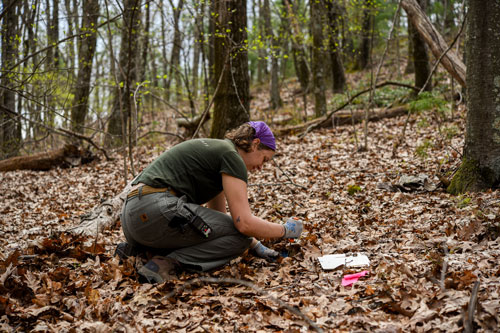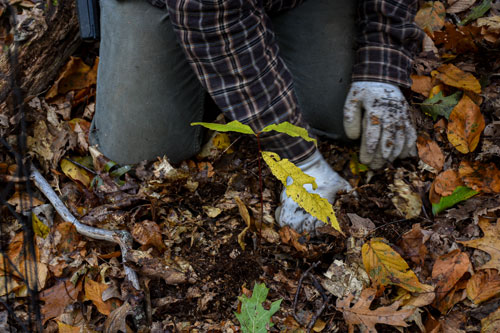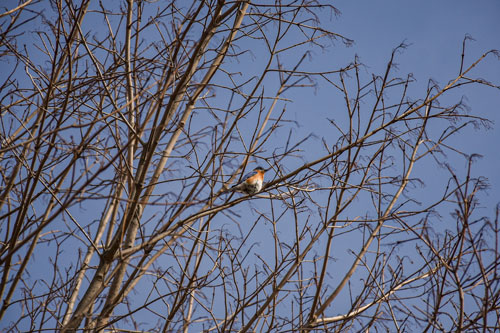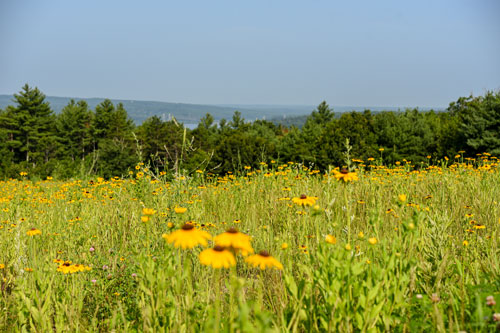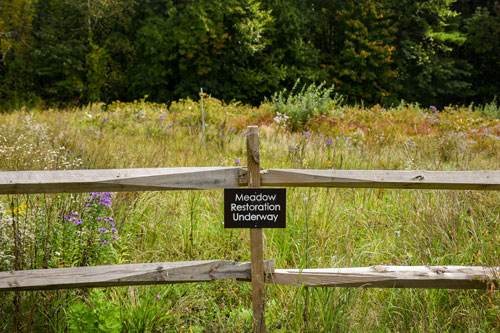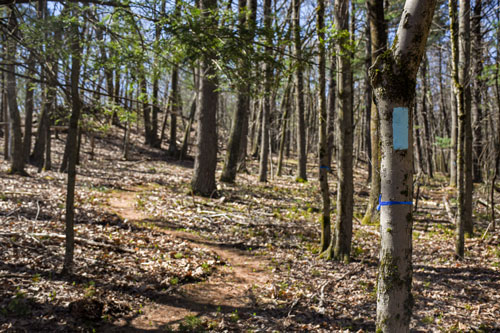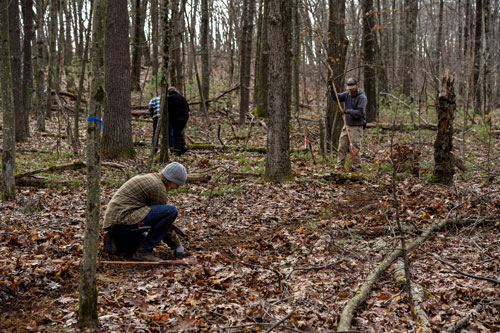CONSERVATION INITIATIVES
Botanic gardens have always been places of learning. In the age of climate change and dramatic biodiversity loss, botanic gardens are tasked with doing more when it comes to protecting natural resources, engaging in research, and inspiring environmental stewardship. New England Botanic Garden is expanding in these areas, engaging in conservation efforts that align with our strategic initiatives.
AMERICAN CHESTNUT RESTORATION PROJECT
New England Botanic Garden recently became part of an American chestnut tree restoration effort that is different from many others — it utilizes 100% pure American chestnut trees (Castanea dentata) that are naturally blight resistant. These trees have not been hybridized or genetically modified for blight resistance, and they represent a unique and hopeful path forward in the still-evolving story of American chestnut restoration. Learn more about this project in our blog.
This restoration effort is led by the American Chestnut Cooperators’ Foundation (ACCF), a Virginia-based nonprofit with participating growers spanning 22 states and Canada. ACCF was chartered in 1986 by researchers who discovered a population of American chestnuts that survived the blight that wiped out more than 3.5 billion others. They believed that blight resistance could be improved by measuring resistance scientifically and carefully building it through a traditional backcross breeding program. Thanks to the tremendous success of their decades-long work, an ever-increasing percentage of their 100% American chestnut trees survive and even thrive in the best sites. New England Botanic Garden is proud to be one of these sites. The naturalistic setting where we planted 20 seedlings and direct-sowed 160 seeds was once home to mature American chestnuts. We look forward to monitoring the progress of our young trees, expanding on this conservation work, and educating the public about this important species. Explore this project.
FOSTERING WILDLIFE HABITAT
Conserving, restoring, and protecting habitat is a key factor in keeping wildlife species thriving. As changes continue to occur to the landscapes around us, it is vital, more now than ever, to support wildlife for future generations through practices that maintain natural ecosystems, promote biodiversity, and prevent the loss of species.
Today, the eastern bluebird (Sialia sialis) is commonly found throughout New England, but that hasn’t always been the case. Bluebirds were considered a threatened species from the 1920s to the 1970s — their decline due to factors such as toxic pesticide use, habitat loss, and displacement by non-native introduced species. To help support the continued recovery of bluebirds, the Garden’s stewardship team has placed birdboxes in pairs of two throughout many of the Garden’s meadows. Living alongside the bluebirds, tree swallows (Tachycineta bicolor) are easy cohabitants and have nested in a few of the boxes as well. The boxes are monitored weekly by staff or volunteers to ensure the new tenants are using their homes. Learn more about this project.
There are around 24 acres of meadows at the Garden. Meadows provide an important type of habitat. They help maintain biodiversity, store carbon, and much more. Meadow habitat is also under threat in many areas due to human development and suppression of natural disturbance events. In place of natural disturbance events such as wildfires or flooding, the Garden utilizes strategically timed mowing that encourages development of secondary successional habitat — the process in which natural species replace, or succeed, one another — and offers places for plants and animals that rely on environmental disturbance. Learn more about the Garden’s meadows and how they’re managed at our blog.
LAND CONSERVATION
Land conservation is one of the most important actions we can take to support biodiversity and protect natural resources. From providing habitat for native species to protecting drinking water and sequestering carbon, land conservation offers myriad benefits to people and the natural world we all enjoy.
The Garden has steadily grown its footprint since its establishment, preserving open space around the core garden property. Most recently, a 14-acre adjacent parcel of wetland and wetland buffer, dubbed the Joslin Lot, was acquired in 2023. A conservation restriction protects this land from any future development, but the Garden will be able to create low-impact walking trails so visitors can experience the site and the unique habitat types found here. Learn more about this special property at our blog. While plans for the Joslin Lot trails are still in the works, other expansions to our trail system are well underway. Two new trails, the Summit Trail extension and the North Woods Trail, opened in spring 2024 giving visitors access to beautiful mixed hardwood forests.
Throughout the Garden’s trail system, visitors will find an understory of witch hazel (Hamamelis virginiana), mountain laurel (Kalmia latifolia), high and lowbush blueberry (Vaccinium corymbosum and V. angustifolium), and American chestnut (Castanea dentata) stump sprouts growing among oaks (Quercus spp.), red maple (Acer rubrum), white pine (Pinus strobus), and black and grey birches (Betula lenta, B. populifolia).
The Loop Trail starts at the intersection of trail between the Wildlife Refuge Pond and the start of the Wildlife Garden. It follows along the external boundary of the Shade Garden and continues through the Garden’s woods before coming back out to the meadows and Orchard Road.
The Loop Trail is a mostly gravel/stone dust path. It is considered easy to navigate but does have roots, rocks, and other potential hazards to be aware of. The path is 1 mile and takes the average visitor approximately 15–20 minutes to traverse. It can be walked from either direction. There are no blazes for this trail.
The Summit Trail begins at an intersection of paths between the Belvedere and the bathroom building in The Ramble. The trail navigates visitors to the top of Tower Hill, to where the old surveying tower stood and an overlook of Mount Wachusett and the Wachusett Reservoir. The new portion of the trail continues past the lookout and into the woods behind The Ramble and Inner Park, weaving visitors among oaks and white pines before leading into the back of the Inner Park.
The Summit Trail is a dirt path. It is considered difficult due to the steep and uneven terrain. The path is 0.25 miles long and takes the average visitor approximately 8–10 minutes to traverse. The trail can be walked in either direction and is blazed with coral markers.
The North Woods Trail is located along the Summit Trail. It can be found by taking the Summit Trail from the side closest to the Inner Park. The North Woods Trail takes visitors on a hike deeper into the woods at the northern end of the Garden’s property.
The North Woods Trail is a dirt path. It is considered difficult due to the steep and uneven terrain. The path is 0.5 miles long and takes the average visitor approximately 10-15 minutes to traverse. The trail can be walked in either direction and is blazed with a light blue/teal color.
INVASIVE SPECIES MANAGEMENT
The Massachusetts Invasive Plant Advisory Group (MIPAG), defines invasive plant species as “non-native species that have spread into native or minimally managed plant systems in Massachusetts. These plants cause economic or environmental harm by developing self-sustaining populations and becoming dominant and/or disruptive to those systems.”
The Garden has faced a handful of invasive species over the years, and it’s tough work. That’s because the horticulture team’s primary means of controlling these invasive species is through mechanical management—this means cutting, manually pulling, and mowing. These removal techniques, carried out by staff and volunteers, cause less harm to the environment than other methods. Along with manual management, harder to control invasive plants are sometimes met with targeted pesticide applications. Cut and paint, and hack and squirt methods are the two most used by the horticulture team. All invasive plants on the property are targeted using direct applications, which allows for the smallest environmental impact.
Read our blog to learn more about how ecological restoration is taking shape in our Wildlife Garden, a space where patience and dedication pays off when it comes to managing invasive species.
The Garden’s top invasive plant species include Asian bittersweet (Celastrus orbiculatus), multiflora rose (Rosa multiflora), burning bush (Euonymus alatus), Japanese honeysuckle (Lonicera japonica), and garlic mustard (Alliaria petiolato).
Public gardens and arboreta are uniquely qualified in taking the initiative in assessing and tracking which non-native species display characteristics of those that qualify as invasive. New England Botanic Garden is an actively participant of Public Gardens as Sentinels Against Invasive Plants (PGSIP), a group of 44 public gardens and arboreta across North America that identify and share observations of plants escaping cultivation in a collaborative process.


